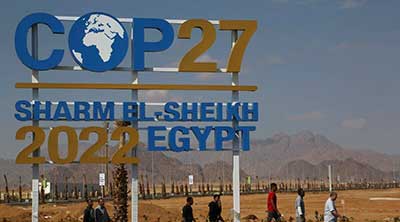Date: 22/11/2022
Relevance: GS-3: Climate Change and International Conventions.
Key Phrases: Climate Change, Warsaw International Mechanism (WIM), Santiago Network, Climate Adaptation, COP(Conference of Parties), UNFCCC, Developed Countries, Mitigation Efforts, Global Warming, Climate Adaptation Cost, Credibility, UNEP, Climate Challenge, GHGs Footprint, Carbon Neutrality, Net Zero Emission, Climate Action Network (CAN).
Context:
- Recently, COP27 Parties proposed the “Loss and Damage Fund Facility” to assist developing countries in responding to loss and damage.
Key Highlights:
- This was the first time climate change loss and damages were part of the official agenda for the world's largest climate conference.
- When the Paris Agreement was adopted in 2015, loss and damage were
referred to as the "third pillar" of climate action.
- However, the Paris Agreement made no mention of any financial commitments to support countries facing significant loss and damage.
What is a Loss and Damage Fund Facility?
- It refers to the finance facility to assist developing countries that
are particularly vulnerable to the adverse effects of climate change in
responding to economic and non-economic loss and damage associated with the
adverse effects of climate change, including extreme weather events and slow
onset events.
- Loss and damage are often divided into economic loss and damage including livelihoods and property and non-economic loss and damage including loss of life and losses to biodiversity and cultural heritage.
27th Conference of Parties (COP27)
- The 2022 United Nations Climate Change Conference, also known as COP27, is the 27th United Nations Climate Change conference.
- It was held in Sharm el-Sheikh, Egypt from November 6 to November 18, 2022.
- It was an important meeting because the latest science shows that climate change is moving much faster than we are, pushing ecosystems and communities to their limits.
- The Conference of Parties comes under the United Nations Climate Change Framework Convention (UNFCCC) which was formed in 1994.
- The UNFCCC was established to work towards the “stabilisation of greenhouse gas concentrations in the atmosphere.”
Outcomes of COP 27
- Loss and Damage Fund Facility
- A breakthrough agreement was proposed to provide “loss and damage” funding for vulnerable countries hit hard by climate disasters.
- Governments also agreed to establish a ‘transitional committee’ to make recommendations on how to operationalize the new funding arrangements.
- Operationalization of the Santiago Network
- Parties agreed on the institutional arrangements to operationalise the Santiago Network for Loss and Damage, to catalyze technical assistance to developing countries that are particularly vulnerable to the adverse effects of climate change.
- Technology
- COP27 saw the launch of a new five-year work program at COP27 to promote climate technology solutions in developing countries.
- Mitigation
- A mitigation work programme was launched in Sharm el-Sheikh, aimed at urgently scaling up mitigation ambition and implementation.
- The work programme will start immediately following COP27 and continue until 2030, with at least two global dialogues held each year.
- Governments were also requested to revisit and strengthen the 2030 targets in their national climate plans by the end of 2023, as well as accelerate efforts to phasedown unabated coal power and phase out inefficient fossil fuel subsidies.
What are the Major Concerns?
- The big challenge is to get it going by filling it with money, identifying fair recipients, and offering them timely help (compensation).
- There is a lack of clarity on which countries will be eligible to receive funds through the financing facility.
Warsaw International Mechanism (WIM)
- About
- It was established to address loss and damage associated with impacts of climate change, including extreme events and slow onset events, in developing countries that are particularly vulnerable to the adverse effects of climate change at COP19 (November 2013) in Warsaw, Poland.
- Features
- It fulfills the role under the Convention of promoting the implementation of approaches to address loss and damage associated with the adverse effects of climate change.
- Santiago Network
- Subsequent deliberations resulted in the establishment in 2019 of a Santiago Network that would connect developing countries to providers of technical assistance, knowledge, and resources.
- It was meant to be a sort of technical arm of WIM.
- In COP27, Parties agreed on the institutional arrangements to operationalise the Santiago Network for Loss and Damage.
Way Forward:
- Countries must now work together to ensure that the new fund can become fully operational and respond to the most vulnerable people and communities who are facing the brunt of the climate crisis.
- For developing countries to enhance their ambition, developed countries must provide enhanced support.
- It requires urgent efforts to increase the financing and implementation of actions designed to adapt to the growing impacts of climate change.
- Developed countries must honour their long-standing obligations under the UNFCCC and the Paris Agreement, including the provision of climate finance, technology transfer, and capacity building to the developing countries.
Conclusion:
- Proposed “Loss and Damage Fund Facility” is only a milestone, not a destination, and there is a long and arduous journey ahead.
- This is an opportunity to further strengthen international cooperation and solidarity whilst delivering justice and protecting human rights.
Source: The Hindu BL
Mains Question:
What do you understand by “Loss and Damage Finance Facility”? In which way does this facility contribute to climate justice? (150 Words).







